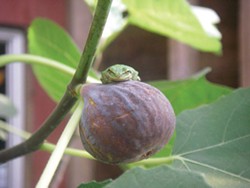[
{
"name": "Top Stories Video Pair",
"insertPoint": "7",
"component": "17087298",
"parentWrapperClass": "fdn-ads-inline-content-block",
"requiredCountToDisplay": "1"
}
]
I can't stop eating them. There's a fig tree at the place where I am staying and I can't seem to keep them out of my mouth! It's a huge tree, maybe 50 years old, sprawling across the low wood fence and dropping down into the neighbors' yard. They don't mind. Every October, both houses get more figs than they know what to do with, just from the one tree. It's a Black Spanish, and it's famous among fig aficionados as being one of most prolific, cold-hardy and easy to grow varieties.
If you don't have figs in your garden, you should plant one immediately! Plant 10! Figs are not only beautiful, delicious, nutritious and easy to grow, they also provide shade and privacy, create habitat for birds and insects, and are star players in food forests from Vermont to Arcata to Spain and back again.
The sprawling nature of a fig leaves space between for annuals and perennials. Try currants, comfrey, seaberry, canna and blueberries, for starters. In last month's article about food forests, I detailed a fig guild. Check it out.
Fig trees can definitely take up a good amount of space, so give it to them. If you live in town or space is limited, plant the figs on an edge, against a back fence or on the parking strip. In the country, plant a patch to create a circular grove or establish a border. I have never had problems with deer eating figs, though your results may vary.
But not all figs are created equal. Many types of figs will literally drown in a wet winter and/or die back all the way to the ground every time it freezes. In our temperate climate, it is important to choose varieties that do well here. Here are my four favorites. Each of these bears fruit at different times, so plant one of each and you'll have an extended bounty. These are available online and at most of the local nurseries.
Black Spanish, as mentioned above, is always a winner. It loves hot summers and wet winters, and can be quite prolific, even in a marginal site. The fruits are medium-sized, dark, firm and juicy, and delicious fresh or dried. Naturally smaller than other varieties, in the right spot it can produce two crops a year.
Desert king is one of the best varieties for maritime gardens because it resists late spring frosts and ripens in mid-summer, even in cooler microclimates. Trees can get quite large.
Lattarulla, aka Italian honey fig, is more of a golden color, excellent for drying and can bear two crops in one season, one ripening in late July and the second in mid-September.
Vern's brown turkey fig, not to be confused with plain brown turkey, was developed by Oregon gardener Vern Nelson and is widely known as reliable, productive and prolific in temperate gardens from British Columbia to the Bay Area. It bears large, sweet brown figs and will often produce two crops a year.
Neverella, also called Osborne prolific, makes stunning, opalescent fruits. Naturally a smaller tree that is more shade-tolerant than other varieties, this is an excellent choice for urban gardens.
Petite negra grows only 3 to 4 feet tall — perfect for your container garden! Medium-sized fruits are reddish black and come twice a year.
You could also just take some cuttings from an existing tree in your neighborhood. Figs are super easy to propagate. If you know of one that does well where you live, just wait until it's done fruiting and then ask to take a few cuttings, either from the tips of the young branches or from the suckers around the base of the tree. If you get lucky, some of those suckers will already have roots growing! Get the cuttings established in pots and plant out in early spring while they are still dormant, or if you can keep the soil evenly moist for a month or two, then you can just stick the cuttings directly in the ground.
Once established, figs can be extremely drought tolerant, but, as with most trees, they need to be watered regularly for the first three years. Use this young-tree time to establish companion perennials before the shade canopy of the fig begins to spread. They respond well to an annual top-dressing of rich compost, but aren't especially needy when it comes to maintenance, fertilizers or pruning. In my experience, figs don't take kindly to being pruned, and whole sections can rot if a cut is made improperly. Prune if you must, but be sure to do it only when the tree is completely dormant: after Thanksgiving and before Groundhog Day.
Fun fact: Figs are an inside-out flower, and some varieties are pollinated by the aptly named fig wasp. Other types of wasps don't pollinate but simply use the figs as a nursery for their larvae. These wasps are also known to hunt insects that are harmful to plants, so having figs benefits your whole garden. "I wish I wouldn't have planted that fig tree" said no one, ever.
more from the author
-
Tales from the Underground
A rainbow of roots from around the world
- Sep 21, 2017
-
Hashtag, Bumper Crop
Veggies to plant now for fall and winter
- Aug 17, 2017
-
Plotting Out Your Garden: Part 2
- Apr 6, 2017
- More »

































